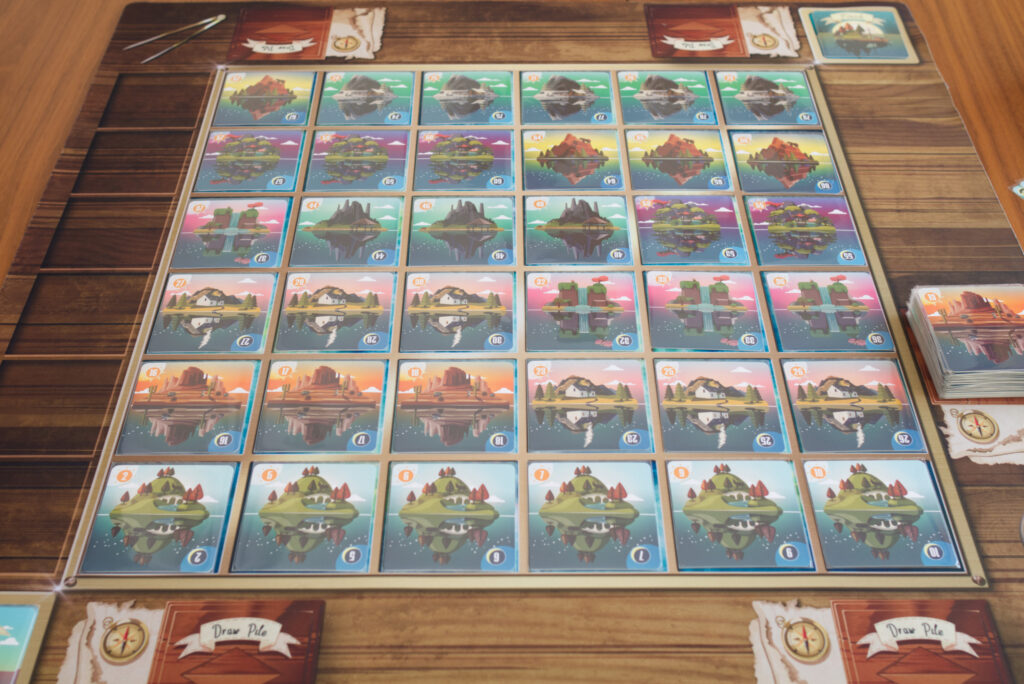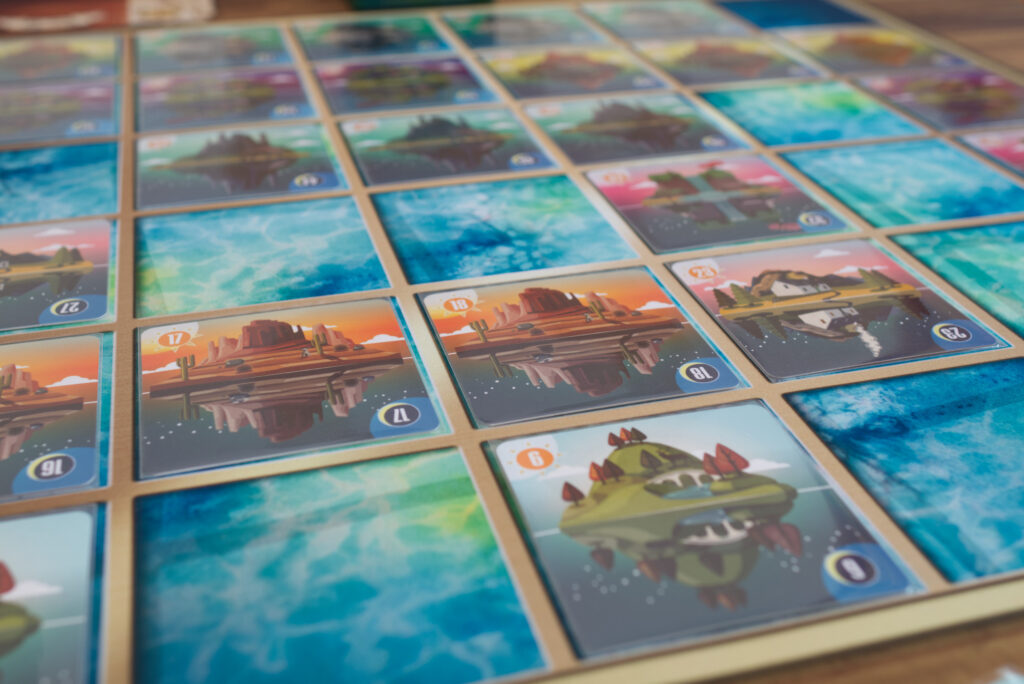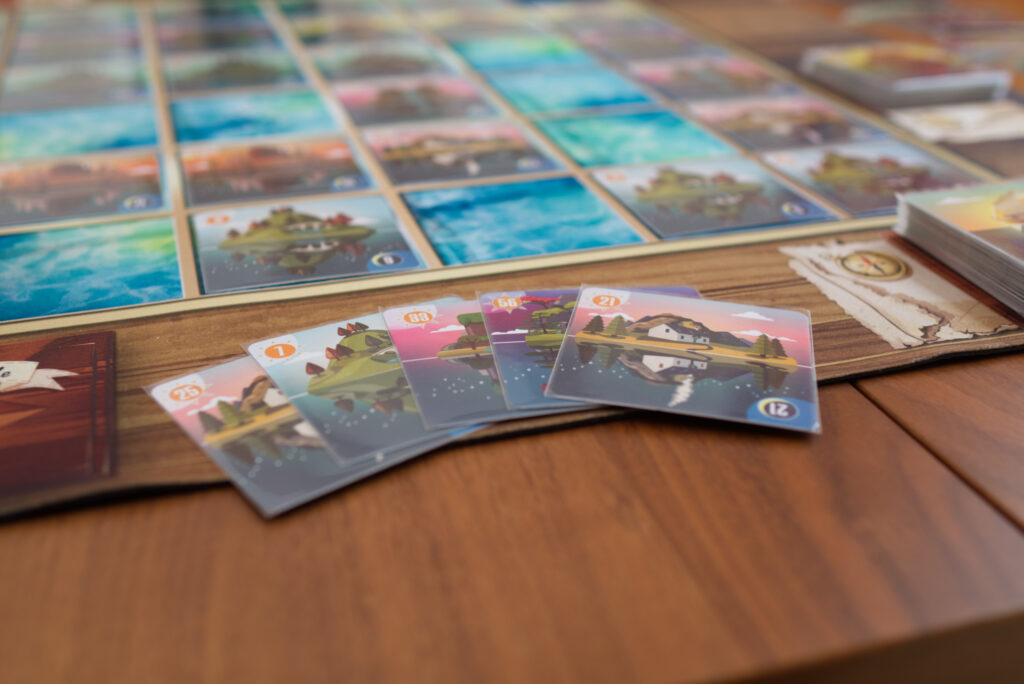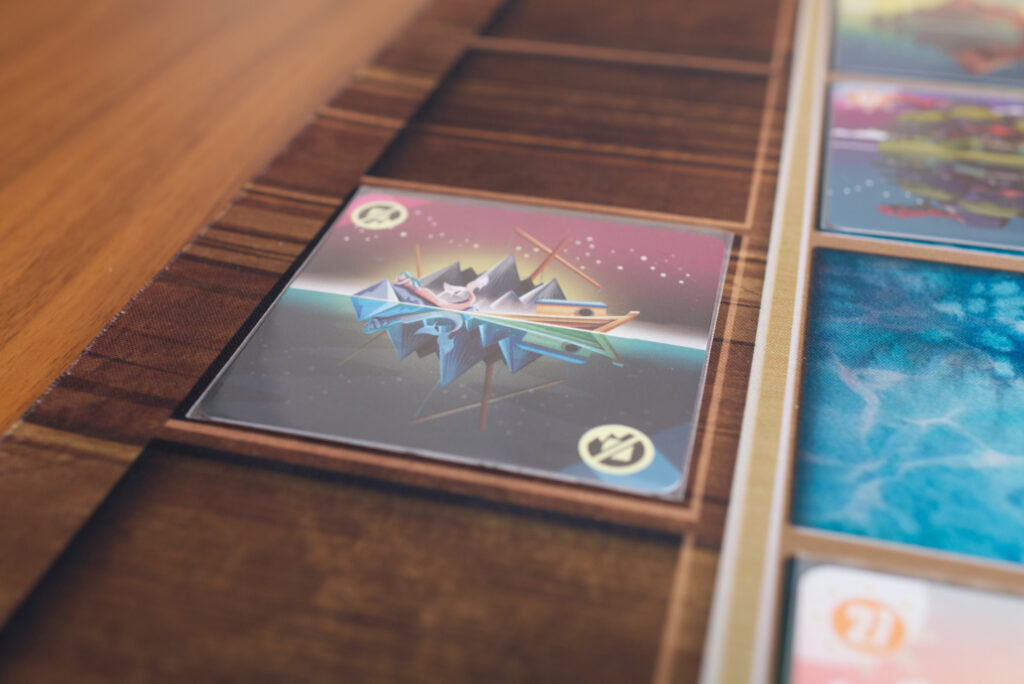I always planned to – at some point – write about games that have been part of my collection for a longer time. I guess it has taken me two years and a current lull of interesting new releases to finally get there. While there are a great many “older” games out there that players can get rather cheap nowadays, the way today’s attention economy works is that most people in the hobby are more interested hearing about “the new stuff” like a recently fulfilled Kickstarter. It’s also difficult to add something to the discussion if there are already dozens of reviews out there for a game.
Tranquility though is a game that ticks a lot of boxes and therefore is worth talking about: tiny box, low price, outstanding artwork, lots of replayability, and something I would call almost universal appeal. Sure, it might not be for everybody, but I still have to find someone to play this with who doesn’t enjoy their time or even asks for another go.

Setup
Tranquility consists of 80 cards numbered 1 to 80, one “start” card per player, five “finish” cards and various optional modules that already come in the box. To set up the game, set aside the start cards and shuffle the 80 numbered cards plus finish cards thoroughly. Split the deck into equal decks for each player. They then draw their starting hand of five cards and then finally shuffle their start card into the deck.
The game also comes with cards that are used to sketch out the border of the 6×6 grid which to fill is the goal of the game. Note that in the images shown here, the optional playmat is used which is illustrated beautifully but quite large and therefore difficult to store or bring along. In general I’m not a fan of playmats but Tranquility is the exception where I would say it’s almost mandatory to get it if you can. It’s not that the game can’t be played without it, but it definitely elevates the enjoyment of this game by simply being there.

The Turn
When it’s a player’s turn they have two options: either play one of their cards into an empty space on the grid – or – discard two cards from their hands. The goal of Tranquility is simple: all players collectively try to fill the 6×6 grid with an ascending order of cards. So the lowest number will be in the bottom left corner and the highest in the top right, with the rightmost card of the first row being considered adjacent to the leftmost card of the second row, and so on. So the grid is actually a long strip of cards where vertical adjacency doesn’t matter.
A new card can be played on any empty space as long as it preserves the overall ascending order of the grid. If there is neither a card to the left nor right of the new placed card (again borders wrapping around to the previous and next row), this is for free and the player simply fills their hand back up to five cards. However, if there are already cards next to where the new card is placed, the player has to pay a penalty of discarding cards equal to the difference to the adjacent numbers, using the smaller one if the card has two neighbours. So if a 19 is placed between a 18 and 23, the player has to discard one card in addition to the card they just had played. Those cards go on a discard pile and are lost for the rest of the game.

This has two consequences: one, players have to roughly keep track which numbers are still in some player’s deck and which won’t come up anymore, otherwise they might create gaps that cannot be filled anymore. Two, the more cards the player has to discard, the quicker they will burn through their deck and ultimately run out of cards. As a result, players typically try to space cards out in the early game instead of immediately placing them next to existing cards.
At the end of the turn, the player then draws back up to five cards, regardless of whether they played a card or simply discarded two cards to cycle their hand, and then passes over to the next player.

Game End
The game is immediately lost if any player runs out of cards and can no longer do a legal action. To win the game however, the grid needs to be completely filled and additionally a start and a finish card needs to be placed. Let’s start with the “start” card. If it’s a player’s turn and they have a start card in their hand, they must play it unless someone else already had played a start card before them. When this happens, all players collectively have to discard 8 cards (for 1 and 2 players, they draw additional cards before having to discard). This can be surprisingly painful because players usually have started collecting certain numbers or building towards good combinations on the board (e.g. saving a 22 if the 21 is already in the grid). Typically this launches a discussion where players argue – without naming specific numbers – that THEY cannot possibly discard more cards because they have this amazing thing on their hand and some other player should do it. It’s quite funny having this moment of partial selfishness in a cooperative game.
The good news is: once a single player has played a start card, any further start cards that are drawn have no effect and can for example be discarded when paying penalties. The other special card in the game is the finish card. There are five distributed throughout the decks of cards and again only a single one is really needed. When the grid is complete, the game is actually won by a player playing a finish card from their hand. Sounds simple, but it will often happen that some player runs out of legal actions to do before another can play the finish card they had been saving on their hand. Or that someone by accident discards the last finish card and the game cannot be won anymore. It’s a nice little piece of tension where during the game you draw a finish card and get annoyed because it has absolutely no use but wish you knew if someone else still has a finish card on their hand so you can discard yours.

Modules & Variants
So far, so simple. Usually it takes new players 1-2 plays to grog the game and stop intuitively wanting to play cards next to each other instead of spacing them out (to avoid penalties). While the standard game is enjoyable, there is little risk as long as players avoid paying large penalties or lose track of the number of already discarded finish cards. As a result, it can get boring quickly and I wouldn’t play the standard game except in a family setting with novice players. Luckily, the designer has already thought of that and added multiple modules and variants in the box.

The modules are:
- Jagged rocks: this is a single card that locks off a row each turn and prevents players from playing any card in that row. After each turn, the card is moved to another row and is finally removed from the game when the fourth of six rows has been completed. This is hands down my favourite module to include and I almost always include it. As a variant, I often use a D6 when playing solo to randomise which row will be locked off.
- The sea monster cards are shuffled into the deck and cannot be discarded once drawn. The only way to get rid of them is to play them on an existing card and remove both from the game. Also the finish card cannot be played as long as any player still has a sea monster card on their hand! This module seems tough at first but with some practice is easy to handle. In certain situations, it can even make things easier as it is the only way in the game to remove an already played card and make room for a better fitting one.
- Storms and compasses: these are a bit odd. The storms are shuffled into the deck and when a storm is drawn, it immediately takes effect. Depending on the colour, they either reduce a player’s hand size to three, lock a row (similar to the jagged rocks), or force players to always play next to existing cards. The only way to get rid of a storm is to gain a compass which can be done in three ways: one is gained when a start card is played, one if a row is filled with consecutive cards (e.g. 15, 16, 17, 18, 19), or if a player discards their whole hand). This module feels the least balanced./ play tested to me and I usually avoid it.
- As a kickstarter exclusive, two “wild cards” were added that can be shuffled into the deck and can replace any other card. I never play with these as I prefer to make the game more challenging instead of less.

Of the variants mentioned in the rule book, there is one I feel that’s really worth mentioning: to remove cards during setup. I like to for example remove 8 random numbered cards during setup which makes the game less predictable and increases the risk of discarding cards. In the standard card, it is relatively safe to discard certain a particular number because players can count on other cards in the same gap coming up later. Removing random numbers spices up the game by a lot and together with the jagged rocks modules is my preferred way of playing. My advise to anyone that only played the standard game and found Tranquility to be boring would be to try this variant and see if they still manage to complete the game successfully.
Solo
When playing solo, setup is changed slightly by making sure that the start card is put into the top half of the deck. Otherwise the game stays unchanged except for the handling of the start card: the solo player draws 8 additional cards before having to decide which 8 to discard. The solo mode works well and I enjoy playing it from time to time as a chilled evening thing after a long day. As with many solo games, the thing that’s missing is a reason for solo players to get this to the table repeatedly, something like a campaign or another way to give new incentives for experienced players. Considering though that this is a cheap game in a small box, having a mini campaign in there cannot really be expected. As a result, replayability feels similar to a roll-and-write game like On Tour: always fun when you do get it to the table but it’s more likely you’ll play it multiplayer.

Conclusion
I enjoy Tranquility for a multitude of reasons, the lovely art and chill game play being chief among them. I can’t think of another game that is so “inoffensive” to anyone and basically everyone gets it instantly. It unfortunately doesn’t quite have the addictive quality of a The Game, but on the other hand Tranquility is easier to play for novice players and the artwork pulls them in more. What also helps is having the nice playmat, but getting that is quite tricky. At the time I got it, I had to contact an ex-colleague of mine in the UK to relay my package because the publisher Board Game Hub wouldn’t ship outside the UK. With the publisher now being defunct, getting the playmat has gotten even more difficult as distributors that are doing reprints of the game never really re-issued the playmat itself. It is quite large, so I cannot really blame them …
The gameplay is surprisingly solid although I strongly recommend experienced players to always use the card-removal variant and throw in a module. I wouldn’t be surprised if a lot of mid-to-heavy gamers completely ignored Tranquility because they played it once with the standard game setup. I do enjoy it both solo and 2p, but having multiple players involved of course heightens the experience as there is less certainty which cards will come up when. There are usually many, many “oh no, why did you have to play that card THERE?!?” moments in every play but the overall success rate is quite high. So Tranquility manages to stay interesting but also be a “safe bet” for the players to have a good time.
The only small criticism I can really think of is that using the 24 single motive border cards feels off to me. It doesn’t look good and seems like a missed opportunity of putting at least some game play content on the back. I could have imagined for example some row/column effects being printed on them or at least them forming a nicer frame. But since there are so many modules and variants in the box already, that’s hardly a reason to complain. As I use the playmat, those cards are permanently banned to the box for me anyway …
Compared to its not-yet-fulfilled successor Tranquility: The Ascent, I would say Tranquility feels “purer” but the Ascent packs in more excitement. I also in particular love the modules in The Ascent as they make the game both quite challenge and also more tactile (e.g. goat meeples running up the hill). There simply is more stuff to do. In the end though, both are different enough that it makes sense to have both in my collection and I don’t see either leaving it any time soon. Good game play, easy to teach, affordable price, tiny box, lovely artwork … what’s not to like about that?
